Asclepias exaltata, Poke Milkweed is a tall native perennial herbaceous plant and like all milkweeds, it is a great source of nectar for its pollinators and other insects. Also, its leaves are food for monarch butterfly caterpillars. It differs from many milkweeds by having its flowers in loose heads.
Flowers
Inflorescence/Flower cluster:
The flower clusters emerge at the top of the stem and from the axils of the upper leaves. The inflorescence is an umbel (flowers spreading from a common point) about 3 inches across. Unlike many milkweeds, there are only a few flowers (around 10) that loosely hang with long pedicels (flower stalks) 1-2 inches long. (Common milkweed has about 100 sessile flowers closely packed!)
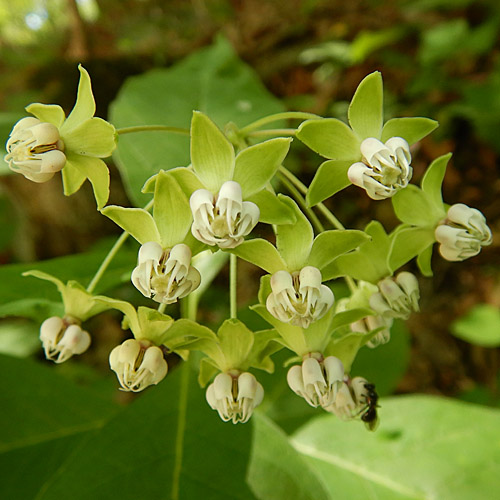
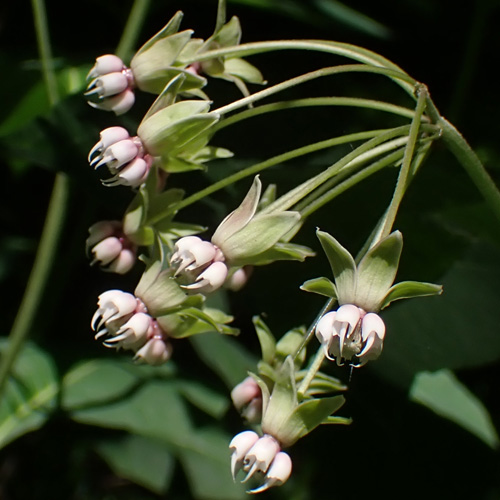

Individual Flower:
Each flower is about 3/8 inches across and 1/2 inch deep. The flower petals and sepals are pale green and the rest of the flower is white, creamy white, or with a tinge of pink. It exhibits the usual milkweed structure.
Flower structure:
Actually, all the milkweeds have similar structure. Labels refer to the photos below. The flower has 5 petals(pt) and 5 sepals(sp).
The flower has both male and female parts and they are fused into structures that are not easily recognizable:
- 5 hoods(hd): In poke milkweed it is truncated at the top but with one or more tall teeth. It is the reservoir for the nectar.
- 5 horns(hn): At the base of the hoods and horns is a plentiful supply of nectar for pollinators and other insects.
-
Central gynostegium (gy): In the center is fused parts of the pistil and the 5 stamens. It is columnar and flat topped.
- The center is the stigmatic chamber/s that is internally divided into 5 chambers that each contain active stigmatic surfaces. The stigmatic chambers also generate nectar that is stored in the hoods. The nectar also serves as the germination fluid for pollen grains. There are 2 ovaries, 3 of the chambers go to one ovary, and the other 2 chambers go to the second ovary.
- 5 stigmatic slits(ss). They are openings into the stigmatic chambers.
- 5 anthers which form 10 anther pouches(an) surround the outer surface of the gynostegium(gy).
Pollen:
- Instead of individual pollen grains, the grains are together in a pollen sac(ps) called the pollinium (pollinia - plural) . Each anther is separated into two anther pouches(an), one on each side of a stigmatic slit(ss).
- Each anther pouch(an) contains a pollen sac/pollinium(ps). Each pair of pollen sacs are connected by translator arms(ta) to a dark sticky/clamp-like corpusculum(cp). These three components make up the pollen apparatus (pollinarium)
Top view of: anther pouches(an) where the pollen sacs are located and where they will exit when pulled by the corpusculum(cp); stigmatic slit(ss) that has a rim that extends outward from the gynostegium (gy); gynostegium (gy) is flat topped.
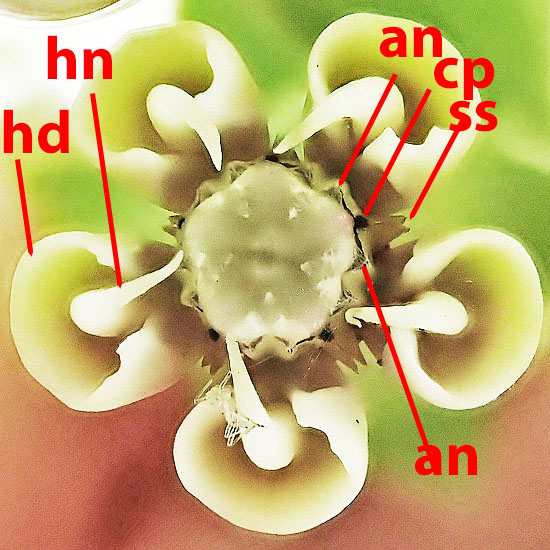
Diagram of a general milkweed flower:
- hn: horn
- cp: corpusculum
- ss: stigmatic slit
- hd: hood
- pt: petal, reflexed
- cp: corpusculum
- ta: translator arm
- ps: pollinia (pollen sac)
 Internet Archive Book Images, No restrictions, via Wikimedia Commons
Internet Archive Book Images, No restrictions, via Wikimedia Commons
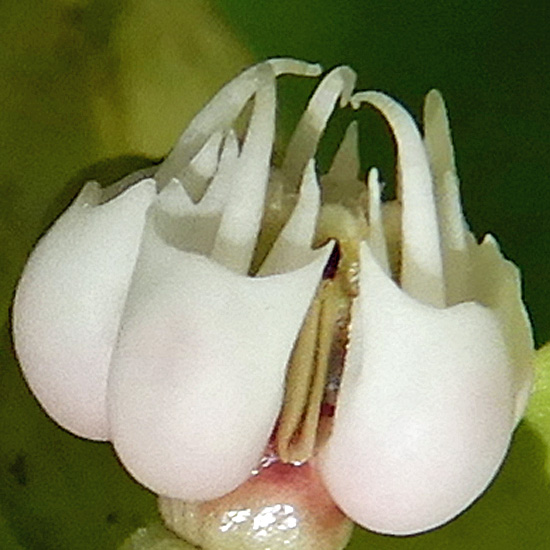
Pollination:
- The way it works: A bee/pollinator comes along and while it is enjoying the nectar at the base of the hoods and horns, a leg slips into a stigmatic slit.
- When the bee tries to remove it leg out of the stigmatic slit, it hits the dark corpusculum which is sticky and sticks on to the bee's leg. While removing its leg with the corpusculum stuck to it, the two pollen sacs that are connected to corpusculum by the translator arms, get lifted out of the top of the anther pouches!
- The bee continues with the whole pollen apparatus dangling from its leg and goes to another milkweed plant
- Amazingly, when the bee lands on another milkweed plant, the pollen sac can be angled so that it goes into the stigmatic slit. Then the stigmatic surface inside the gynostegium chamber get pollinated!
- It is a complicated and amazing way to get a flower pollinated but it works well enough to keep the species alive. It is not always so straight forward. Lots can and do go wrong. Read more about this amazing process in the references below.
Side view: stigmatic slit(ss)-shows how the edge protrudes to aid capturing a bee's leg; hood(hd) is truncated with a few tall teeth; horns(hn) are tall extending above hood and gynostegium(gy); below the hood inside are the two ovaries; bud - pale green sepals
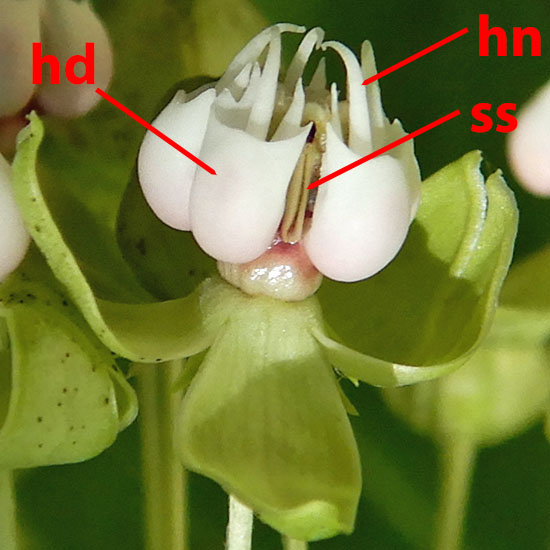
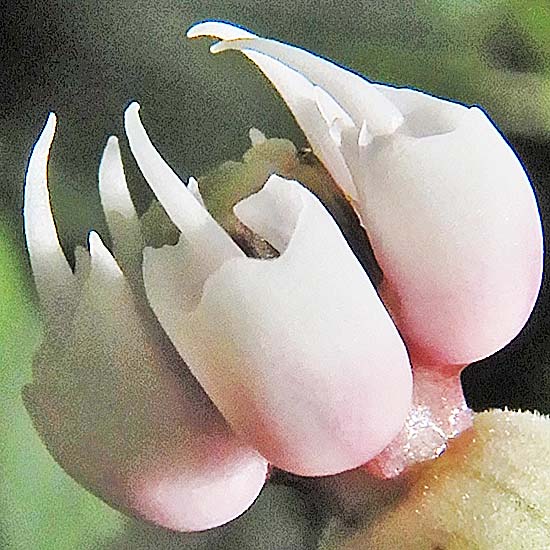
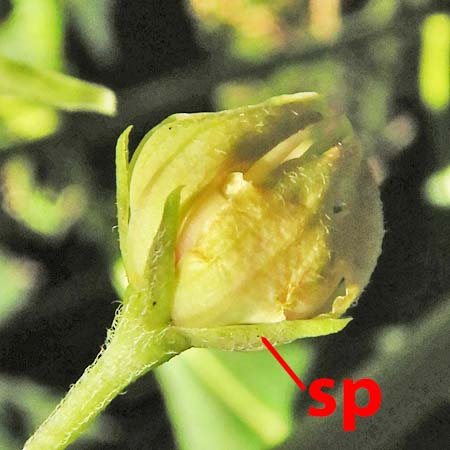
Plant - Leaves - Habitat
The poke milkweed plant is a large upright perennial growing to 5 feet tall with an unbranched stem. It blooms in summer.
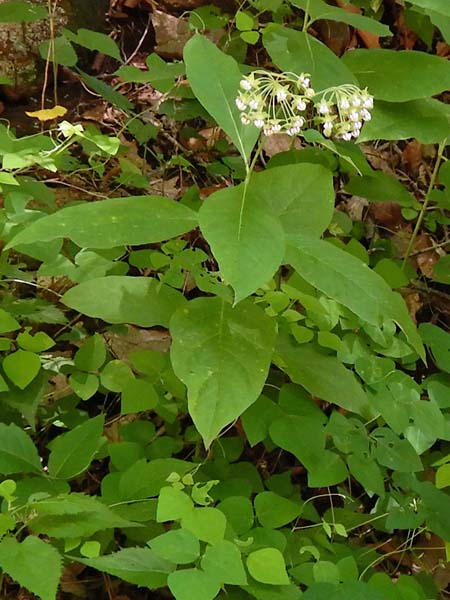
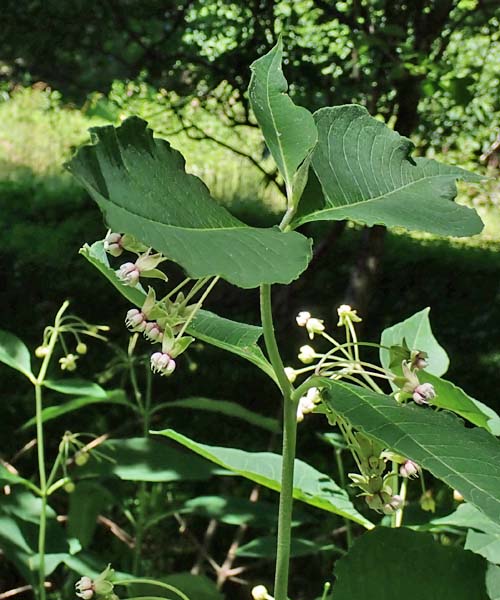
The leaves are simple, opposite. The leaves are large and broad - up to 8 inches long and 4 inches wide. The margins are smooth and sometimes slightly wavy. The leaf shape is slightly broader below the middle or at the middle and tapering at both ends. The leaf stalks (petioles) are short.
Like other milkweeds, when the leaves or stems of poke milkweed are broken, they produce a milky latex. This liquid contains various levels of toxic cardiac glycoside compounds which makes the plants toxic to most insects and animals.
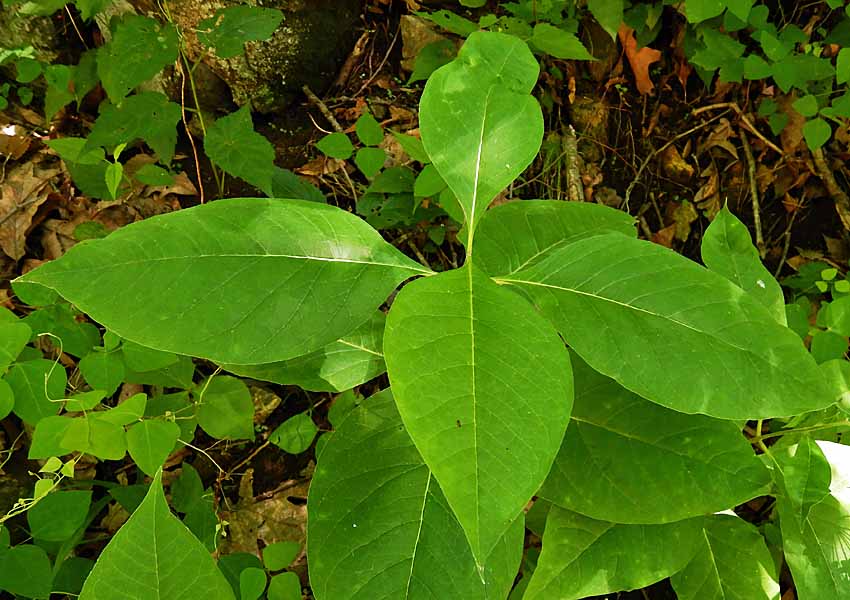
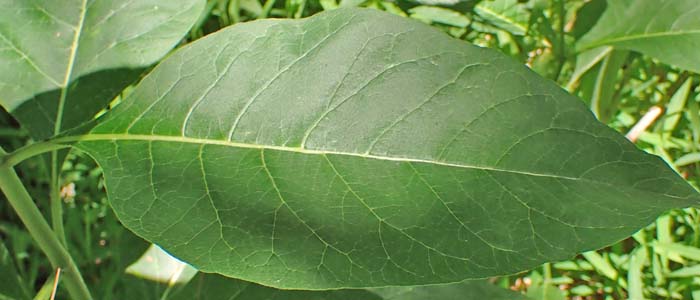
Habitat: moist woodlands, woodland edges, and disturbed areas
Rarity: In New Jersey, poke milkweed, Asclepias exaltata, is S3 (Vulnerable) 2025 but globally secure G5. Inaturalist observations were mainly in central/north Jersey, north of US78 (2025).
Text by Millie Ling and all photos by Hubert & Millie Ling. Photos: Flowers - June 16, 2022 Ken Lockwood Gorge, NJ; July 10, 2023 Julian Price Memorial Park, NC.
Additional information
Additional information / references:
- Minnesota Wildflowers
https://www.minnesotawildflowers.info/flower/poke-milkweed - Illinois Wildflowers
https://www.illinoiswildflowers.info/woodland/plants/pk_milkweed.html - The Intricate Dance of Milkweed Pollination: has a good drawing
https://www.hachettebookgroup.com/articles/the-intricate-dance-of-milkweed-pollination/ - USDA Milkweed Pollination Biology: excellent description
https://www.nrcs.usda.gov/Internet/FSE_PLANTMATERIALS/publications/nvpmctn12764.pdf - The USDA website shows Asclepias exaltata nativity in the US down to county level and other information: https://plants.usda.gov/plant-profile/ASEX
- NatureServe - rarity & distribution. https://explorer.natureserve.org/Taxon/ELEMENT_GLOBAL.2.145072/Asclepias_exaltata
- Key to NJ Milkweeds, New England has almost the same milkweeds as NJ: GoBotany. https://gobotany.nativeplanttrust.org/dkey/asclepias/#all